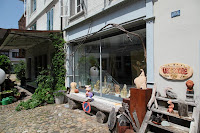However, there's one effect that I haven't yet found an App for. Can you guess what it is? The answer is . . wait for it . . polarisation.
That's right. the humble (if somewhat expensive) polariser filter.
I've always had polarisers in my equipment collection. They are a great accessory and if looked after correctly, will last as long as, if not longer than, your camera gear.
So, what does this marvellous piece of glass do?
To put it briefly, it removes reflections from non metallic surfaces and intensifies colours. But, there is a caveat. The effect will be most effective when used at right angles to the sun. This means that if you are using it to remove glare from a shop window, then don't stand full on to the window.
The polariser has two rings. One has the filter thread and remains fixed on the lens while the other rotates. The effect of this rotation is visible when looking at a live image through the viewfinder. You notice the effect, whether it's reflections disappearing, blue skies getting more intense or colours intensifying as you turn the ring.
Here are a few examples that I took a couple of weeks back. This was a spur of the moment thing so I didn't have a tripod with me to produce exactly the same field of view in each image. I had to first take the picture, then screw the filter on and rotate it for the best effect and then take the next picture.
I saw this interesting shop window in the town of Wangen an der Aare. It was a very sunny day (ideal for polarisers) but there were lots of reflections. Standing at a right angle to the window I rotated the front filter ring whilst observing it through the viewfinder. When I saw that it had removed most of the glare, I took a picture.
Before and after
One thing to note, when using the polariser is that it cuts down on the light reaching the film / sensor. to counter this, you can either increase the ISO or use a tripod if you think that the exposure will be too slow.
Then it was down to the river where I wanted to demonstrate the water reflection killing capabilities of the polariser.
As if more proof were needed. Here is my favourite example shot from that day. Just look at how much more intense and clear the water is in the second photo when compared with the un-polarised first picture
Another word of warning. As I mentioned earlier, the filter consists of two rings. If you are using one on a very wide lens, you may experience vignetting where the filter is visible in the corners of the image (i.e.dark corners). To combat this, take off any other filters already on the lens or buy one of the newer generation of slim filters.
Thanks for reading. Please feel free to leave any comments or even ask a question or two!







No comments:
Post a Comment